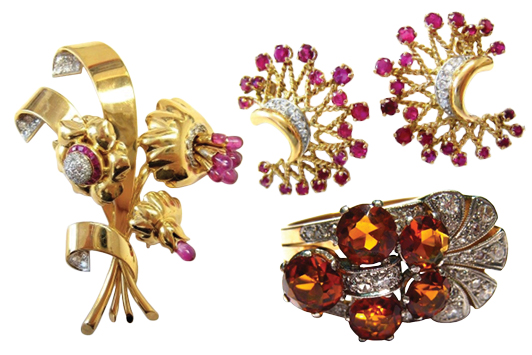
Is Retro jewelry trending?
We’re coming out of a cycle where small and demure was what everyone was after — skinny little hoop earrings and slim bracelets with tiny centers. Now, big and vibrant is back. And if big is back, that means Retro is hot again. Its size and bold designs are what made it so popular before, and that’s what will attract customers today.
What are the main characteristics of Retro jewelry?
Retro jewelry is what I call celebratory jewels. World War II was over, and everyone was celebrating and in a good mood. Women wanted to express themselves with big, colorful pieces. Retro jewelry was polished gold with very tiny star-set diamonds. It was about great color, rings with a 30-carat amethyst and two little citrines, or a big blue topaz or an aquamarine with two tiny little rubies. It was yellow gold jewelry because platinum had been reserved for the war effort. It wasn’t about the most valuable stones. What were known as semiprecious gems became the stones du jour.
People wanted to be noticed. Women wore big hats, and men wore suits with big lapels. It was a period where designs were fun, slightly whimsical, overscaled. There also was a newfound respect for transformable jewelry, the clip that you could just as easily put on a chain as wear on your lapel.
Which makers of the period were most noteworthy? Which types of jewelry were most in demand?
Retro jewelry was best known for the brooches. Let’s give a nod to that. And it was about big rings and chunky bracelets, like the tank bracelets.
All the big designers were creating pieces. I think it was one of the strong periods of Van Cleef & Arpels, with their Ludo clip and Passe-Partout styles [featuring] pale sapphires and maybe a few rubies in the center in a yellow gold mounting.
With the great jewelry houses of Paris and Italy dealing with the aftermath of the war on their shores, America became a jewelry center. Trabert & Hoeffer-Mauboussin was big in the Retro period; that’s when [the company] shone with designs like its Reflection series. Tiffany & Co. was great as well.
Which types of Retro jewelry are most popular to stock?
The biggest bang for the buck is a brooch, but they are less marketable in terms of demand. Bracelets and big rings are probably the easiest to find and best to stock.
Postwar jewelry was being made for everybody, accessible at every level of income. So it’s not a scarce period, but of course, not everything was the best design. I find that Retro jewelry is still undervalued in many auction rooms, and I buy from dealers. The number-one thing I look for is condition: that the piece is original, not transformed into something it wasn’t intended to be, and the genuineness of a signed piece. If I’m paying a premium for a particular maker’s name, my mantra is always that it should look like it’s the work of the maker. There are certain things that look like Van Cleef pieces or Tiffany pieces or Cartier, and so on. Retro is one of my favorite periods; it really was special.
Article from the Rapaport Magazine - July 2021. To subscribe click here.